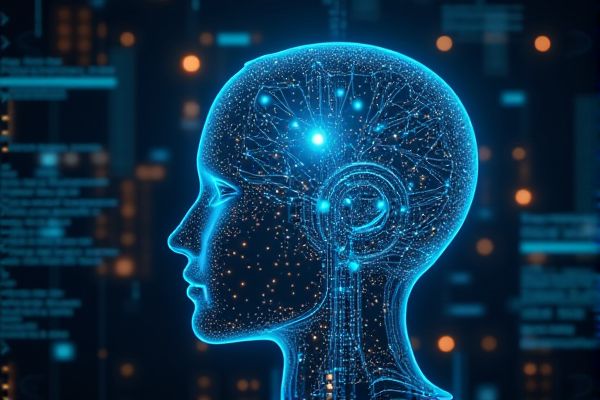
AI streamlines the recruitment process by using algorithms to sift through resumes, identifying the most suitable candidates based on specific job requirements. It enhances employee engagement by analyzing feedback and sentiment from various communication channels, allowing HR teams to tailor their strategies effectively. Predictive analytics forecasts employee turnover, providing valuable insights that help in retention strategies and workforce planning. AI-driven training platforms offer personalized learning experiences, ensuring employees develop skills that align with organizational needs and individual career goals.
AI usage in human resources
Talent Acquisition Analytics
AI in human resources, particularly in talent acquisition analytics, offers the potential for more efficient hiring processes. By analyzing candidate data, companies can identify patterns that may lead to better selection outcomes. For example, firms using platforms like LinkedIn can leverage AI to match candidates with job roles more accurately. This approach increases the chance of finding suitable talent while reducing time-to-hire metrics.
Employee Engagement Measurement
AI can streamline the employee engagement measurement process by analyzing large volumes of feedback data quickly and accurately. Tools like survey platforms leverage AI to interpret sentiment, providing real-time insights into employee morale. This enables HR departments at institutions like Tech Innovations Inc. to identify areas for improvement and tailor initiatives more effectively. The potential for increased productivity and job satisfaction makes implementing AI in this context a promising strategy.
Predictive Attrition Analysis
Predictive attrition analysis in human resources leverages AI to identify potential employee turnover. By analyzing patterns in job satisfaction, performance metrics, and engagement levels, organizations can proactively address factors leading to attrition. For instance, a company like IBM may use this analysis to tailor retention strategies based on data insights. This application of AI presents a chance for organizations to enhance employee retention and reduce hiring costs.
Automated Onboarding Processes
Automated onboarding processes in human resources can streamline the integration of new employees, reducing the time and resources required for training. These systems, such as SAP SuccessFactors, help create a personalized experience that can enhance employee satisfaction from the start. Implementing AI in this area may lead to improved retention rates, as employees feel more supported and engaged. The possibility of leveraging data analytics for continuous improvement presents a significant advantage for organizations seeking to enhance their onboarding procedures.
Personalized Learning and Development
AI usage in human resources can enhance personalized learning and development by analyzing employee data to tailor training programs. For example, companies like IBM utilize AI to assess skill gaps and recommend specific courses to employees based on their career aspirations. This targeted approach increases engagement and effectiveness, maximizing the potential of the workforce. The chance for organizations to improve employee satisfaction and retention rates rises with these tailored learning paths.
Bias Detection and Mitigation
AI can enhance human resources by identifying and minimizing biases in recruitment processes. Tools like Natural Language Processing can analyze job descriptions for gender-coded language, thus promoting a more inclusive hiring strategy. Companies that implement these technologies may see improved workplace diversity and employee satisfaction. By leveraging bias detection algorithms, organizations can foster a fairer environment, potentially attracting a wider talent pool.
Workforce Planning Optimization
AI in human resources can enhance workforce planning optimization by analyzing large data sets for better decision-making. For example, institutions like Deloitte utilize AI to predict staffing needs based on historical trends, which may lead to improved workforce efficiency. The technology can identify skill gaps and recommend training programs, potentially fostering employee development. Such capabilities present a significant opportunity for organizations to align their human resources with business objectives more effectively.
Performance Management Insights
AI can streamline the recruitment process by analyzing large volumes of resumes to identify the best candidates, enhancing the efficiency of hiring. In performance management, AI tools can provide insights into employee productivity and engagement levels, allowing for more informed decisions on promotions and training needs. Companies like Google have leveraged AI to improve employee retention by predicting potential turnover risks. The integration of AI in human resources creates opportunities for data-driven strategies that could lead to a more effective workforce management approach.
Compensation and Benefits Structuring
AI can streamline compensation and benefits structuring by analyzing market data to ensure competitive salary offerings. For example, companies like Google utilize AI tools to tailor their employee benefits packages based on individual needs and preferences. This technology can help identify trends and predict employee satisfaction, thereby improving retention rates. The possibility of automating these processes allows HR teams to focus on strategic planning rather than administrative tasks.
HR Decision-Making Automation
AI can enhance efficiency in HR decision-making by automating processes such as resume screening and candidate selection. For example, institutions like Deloitte have leveraged AI tools to analyze employee performance data, leading to more informed hiring choices. This automation allows HR professionals to focus on strategic initiatives rather than administrative tasks. The potential for improved candidate matches and reduced time-to-hire demonstrates a significant advantage for organizations embracing AI in HR.
 techknowy.com
techknowy.com